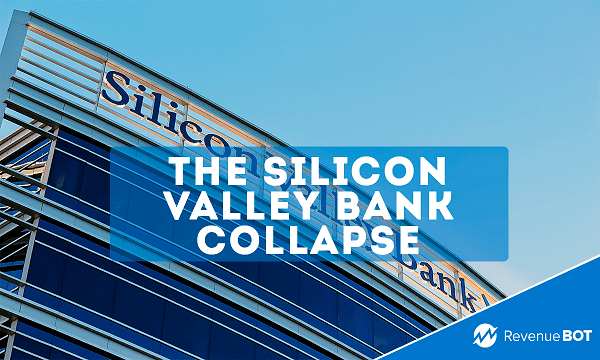
The third month of 2023 passed. And then comes the news about one of the largest banks in the U.S. failing. Such an event turned out to be the second high-profile bankruptcy among U.S. commercial banks over the past few months. Let us cover in this article how this could happen, and what was happening behind the scenes of the bank as well as how it may affect all of us.

How SVB came to be?
It was 1983 when a bank in California took a unique approach to their business, that is, they opted to focus on startups and intentionally targeted gifted young minds who were creating profitable ventures and raising significant funding from venture capitalists. The bank’s name, Silicon Valley Bank (SVB), seemed like a good choice since it was located in the heart of Silicon Valley. This strategy proved to be quite productive as Silicon Valley served as the hub of fast-growing tech companies that generated tremendous amounts of wealth, some of which flowed into SVB coffers over several decades.
As we move to a timeframe between 2020 and 2021, the tech industry in the United States was enjoying an astonishing boom. Immense amounts of money have been poured into the financial system, much of it was to invest in cutting-edge tech businesses, all under the slogan of combating the pandemic. Throughout this period, the Nasdaq-100 index nearly doubled, while startups sought to go public and raise huge sums of capital directly from venture capitalists.

As anticipated, the fortunes of SVB, which serves these tech startups, have skyrocketed. The bank’s customer deposits more than tripled over that period, leading to an excessive surge in the bank’s stock price, which reached about $200 billion by early 2022. As a result, Silicon Valley Bank now ranks as the 16th largest bank in the United States and the second largest in California.
Why did the SVB go bankrupt?
Despite its resounding success, SVB faced a handful of problems during the years leading up to its bankruptcy. Despite its resounding success, SVB faced a handful of problems during the years leading up to its bankruptcy. One of the major challenges included the bank’s exposure to risky loans in the tech industry, in particular in the areas of electric vehicles and renewable energy. With the market in these industries getting more and more crowded, a lot of companies were struggling to compete and could not afford to pay back their loans.
Moreover, SVB faced mounting rivalry from other banks, which had begun to focus on serving the tech industry. This led to a drop in the market share and income of the bank.
Ultimately, the coronavirus pandemic affected SVB’s financial performance significantly. What the bank faced was an increase in non-performing loans and a decline in demand for its services as many companies struggled to stay afloat during the lockdown.
The combination of all these factors gradually caused the bank to collapse.
How the bankruptcy of SVB hit shares of other U.S. banks?
It was impossible for the news of the Silicon Valley Bank collapse not to adversely affect the shares and their value of other American banks. Numerous investors started worrying that other banks operating in the tech industry might also suffer significant losses.
For several days, following the announcement of the SVB bankruptcy, the value of the securities of several major U.S. banks, including JPMorgan Chase and Bank of America plummeted considerably. Still, this drop was momentary, while share prices of most banks eventually began to climb back up.
How the global economy might be impacted?
The bankruptcy of Silicon Valley Bank could have profound consequences for the world economy as a whole. Given that the bank maintains a large presence in several countries, its collapse could lead to disruptions in financial markets around the world.
Furthermore, the collapse of SVB might have an impact on the technology industry, a sector that depends heavily on access to capital from banks and other financial institutions. Should other banks become more cautious about lending to tech firms, this could inhibit innovation and growth in the industry.
In conclusion, thecollapse of SVB has the potential to undermine trust in the financial system. This will probably trigger tighter regulatory supervision and tougher restrictions on banks’ lending practices, making it more difficult for companies in all industries to access capital.
What about the crypto market?
As it is known to many, the failure of SVB took its toll on the USDC stablecoin. Why did this happen? It is launched by the fintech company Circle, which is partly owned by Silicon Valley Bank. And as you might expect, it started trading at $0.9. Yet it did so for a short period of time. Now it is recovering progressively.

And what about other digital assets? Despite being in a flat trend for a long time amid the news about Silicon Valley Bank, Bitcoin has sharply jumped up and is trading at $24,350 at the time of writing. This is certainly positive news for the crypto community. Most likely, the surge in price occurred due to the fact that ordinary citizens do not understand where it is better to invest their capital, since the banking system is so unstable now. So the choice fell on digital assets.
Conclusion
Silicon Valley Bank’s bankruptcy is a cautionary tale about the risks that banks face when they focus too much on one industry or market. Although SVB has so far been very successful in serving the needs of the tech industry over the years, its exposure to risky loans and increased competition eventually caught up with it.
The implications of SVB’s bankruptcy for other banks and the global economy are not yet fully understood. However, it serves as a reminder that even the most successful banks are not immune to bankruptcy and that oversight and risk management are necessary to ensure the stability of the financial system.
